Analysis of Organisational Learning and Change at Sanitarium Health
VerifiedAdded on 2023/06/04
|8
|2551
|357
Report
AI Summary
This report provides a comprehensive analysis of organisational learning and change at Sanitarium Health and Wellbeing, an Australian health food company. It begins by diagnosing and analyzing Sanitarium's organizational culture, highlighting its values, norms, and employee-centric approach. The report then evaluates the company's change efforts, supporting its points with facts and data, showcasing its ability to adapt to market shifts and maintain a strong brand image. Furthermore, it examines the factors influencing organizational change and learning principles, such as new technologies, risk-taking, and knowledge management. Finally, the report critically analyzes learning mechanisms and their impact on organizational effectiveness, performance, and reputation, offering recommendations for improvement. The report emphasizes the importance of stakeholder involvement and suggests strategies for enhancing learning and change processes within Sanitarium, ultimately aiming to improve customer health and the company's success.
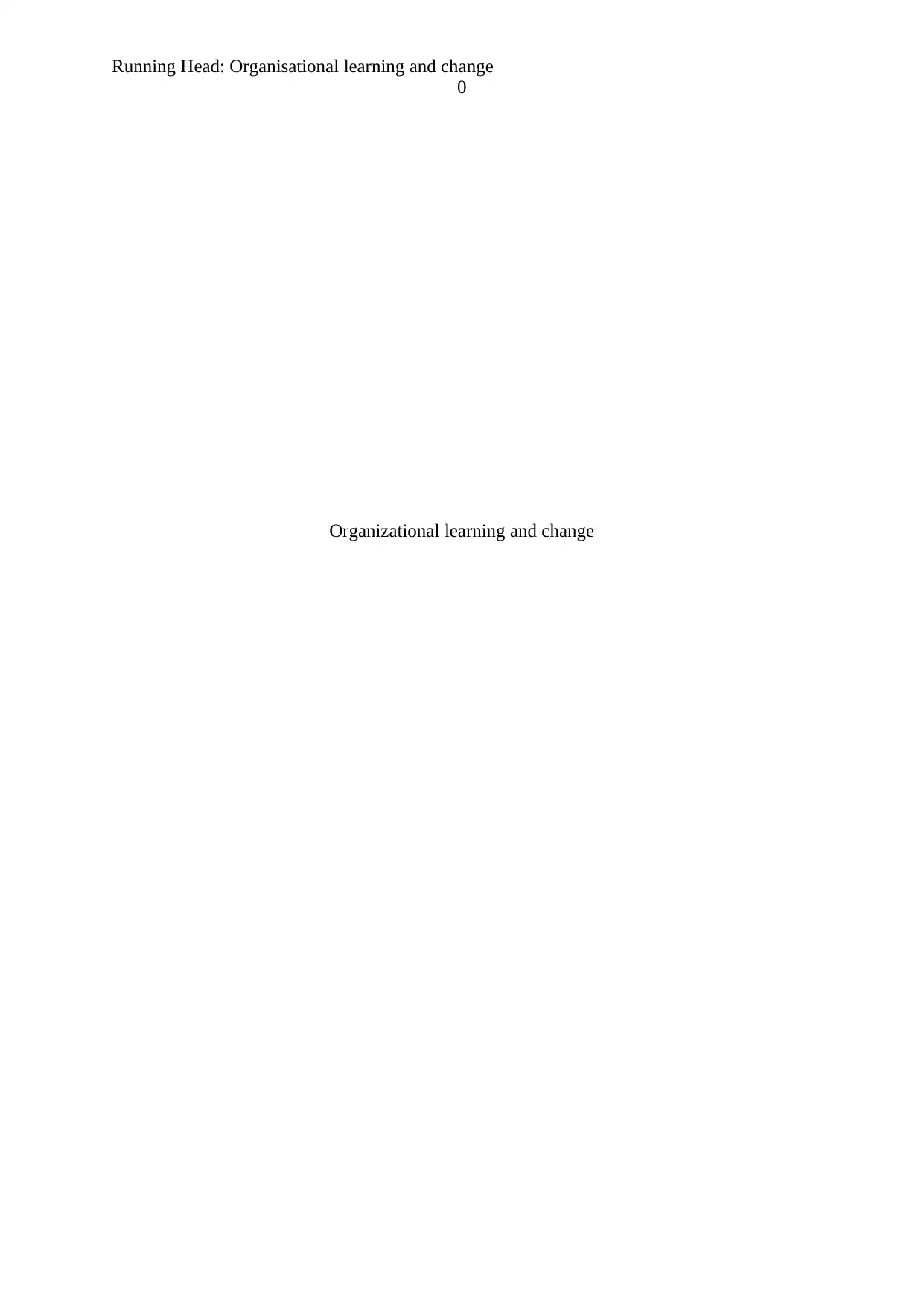
Running Head: Organisational learning and change
0
Organizational learning and change
0
Organizational learning and change
Paraphrase This Document
Need a fresh take? Get an instant paraphrase of this document with our AI Paraphraser
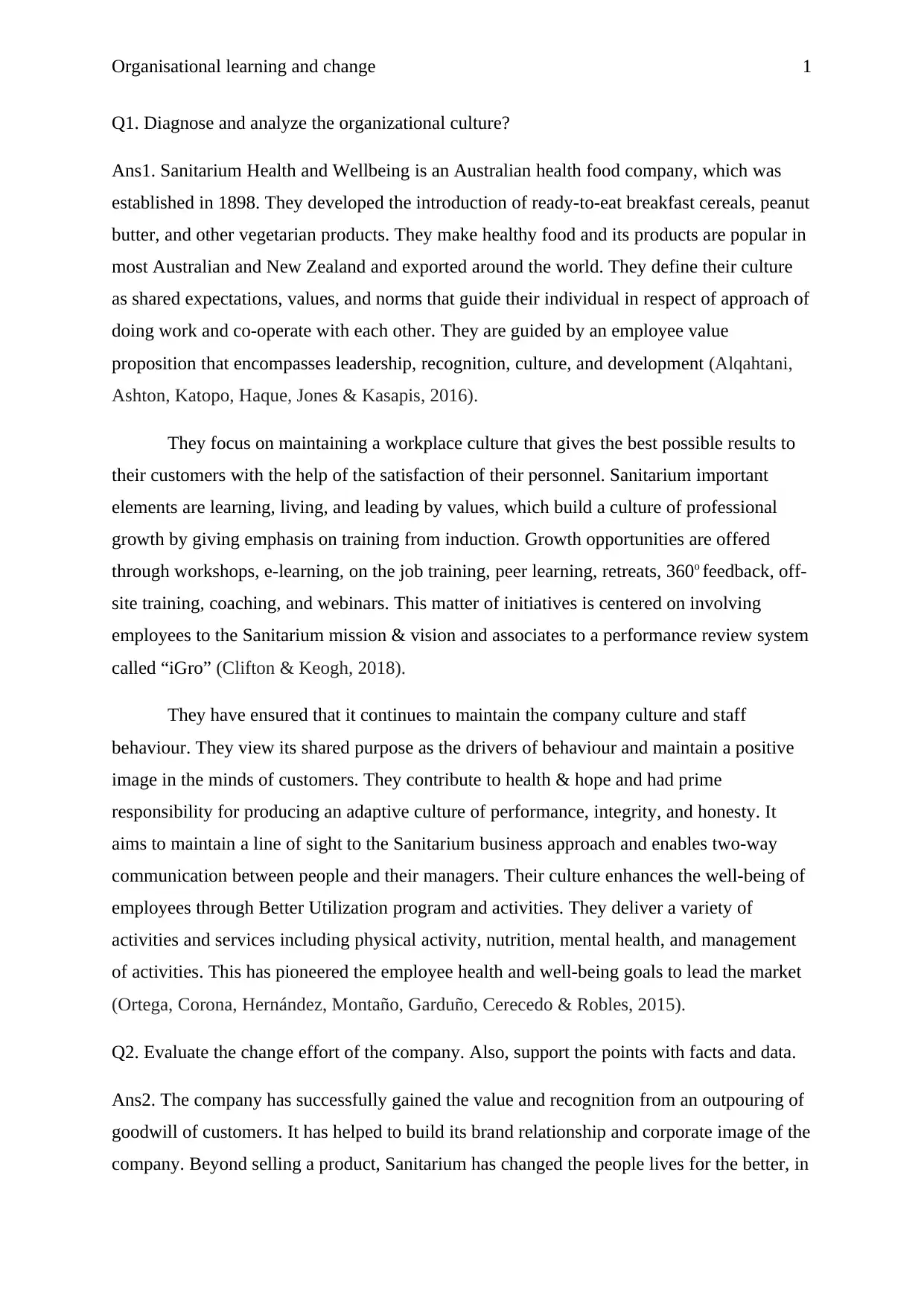
Organisational learning and change 1
Q1. Diagnose and analyze the organizational culture?
Ans1. Sanitarium Health and Wellbeing is an Australian health food company, which was
established in 1898. They developed the introduction of ready-to-eat breakfast cereals, peanut
butter, and other vegetarian products. They make healthy food and its products are popular in
most Australian and New Zealand and exported around the world. They define their culture
as shared expectations, values, and norms that guide their individual in respect of approach of
doing work and co-operate with each other. They are guided by an employee value
proposition that encompasses leadership, recognition, culture, and development (Alqahtani,
Ashton, Katopo, Haque, Jones & Kasapis, 2016).
They focus on maintaining a workplace culture that gives the best possible results to
their customers with the help of the satisfaction of their personnel. Sanitarium important
elements are learning, living, and leading by values, which build a culture of professional
growth by giving emphasis on training from induction. Growth opportunities are offered
through workshops, e-learning, on the job training, peer learning, retreats, 360o feedback, off-
site training, coaching, and webinars. This matter of initiatives is centered on involving
employees to the Sanitarium mission & vision and associates to a performance review system
called “iGro” (Clifton & Keogh, 2018).
They have ensured that it continues to maintain the company culture and staff
behaviour. They view its shared purpose as the drivers of behaviour and maintain a positive
image in the minds of customers. They contribute to health & hope and had prime
responsibility for producing an adaptive culture of performance, integrity, and honesty. It
aims to maintain a line of sight to the Sanitarium business approach and enables two-way
communication between people and their managers. Their culture enhances the well-being of
employees through Better Utilization program and activities. They deliver a variety of
activities and services including physical activity, nutrition, mental health, and management
of activities. This has pioneered the employee health and well-being goals to lead the market
(Ortega, Corona, Hernández, Montaño, Garduño, Cerecedo & Robles, 2015).
Q2. Evaluate the change effort of the company. Also, support the points with facts and data.
Ans2. The company has successfully gained the value and recognition from an outpouring of
goodwill of customers. It has helped to build its brand relationship and corporate image of the
company. Beyond selling a product, Sanitarium has changed the people lives for the better, in
Q1. Diagnose and analyze the organizational culture?
Ans1. Sanitarium Health and Wellbeing is an Australian health food company, which was
established in 1898. They developed the introduction of ready-to-eat breakfast cereals, peanut
butter, and other vegetarian products. They make healthy food and its products are popular in
most Australian and New Zealand and exported around the world. They define their culture
as shared expectations, values, and norms that guide their individual in respect of approach of
doing work and co-operate with each other. They are guided by an employee value
proposition that encompasses leadership, recognition, culture, and development (Alqahtani,
Ashton, Katopo, Haque, Jones & Kasapis, 2016).
They focus on maintaining a workplace culture that gives the best possible results to
their customers with the help of the satisfaction of their personnel. Sanitarium important
elements are learning, living, and leading by values, which build a culture of professional
growth by giving emphasis on training from induction. Growth opportunities are offered
through workshops, e-learning, on the job training, peer learning, retreats, 360o feedback, off-
site training, coaching, and webinars. This matter of initiatives is centered on involving
employees to the Sanitarium mission & vision and associates to a performance review system
called “iGro” (Clifton & Keogh, 2018).
They have ensured that it continues to maintain the company culture and staff
behaviour. They view its shared purpose as the drivers of behaviour and maintain a positive
image in the minds of customers. They contribute to health & hope and had prime
responsibility for producing an adaptive culture of performance, integrity, and honesty. It
aims to maintain a line of sight to the Sanitarium business approach and enables two-way
communication between people and their managers. Their culture enhances the well-being of
employees through Better Utilization program and activities. They deliver a variety of
activities and services including physical activity, nutrition, mental health, and management
of activities. This has pioneered the employee health and well-being goals to lead the market
(Ortega, Corona, Hernández, Montaño, Garduño, Cerecedo & Robles, 2015).
Q2. Evaluate the change effort of the company. Also, support the points with facts and data.
Ans2. The company has successfully gained the value and recognition from an outpouring of
goodwill of customers. It has helped to build its brand relationship and corporate image of the
company. Beyond selling a product, Sanitarium has changed the people lives for the better, in
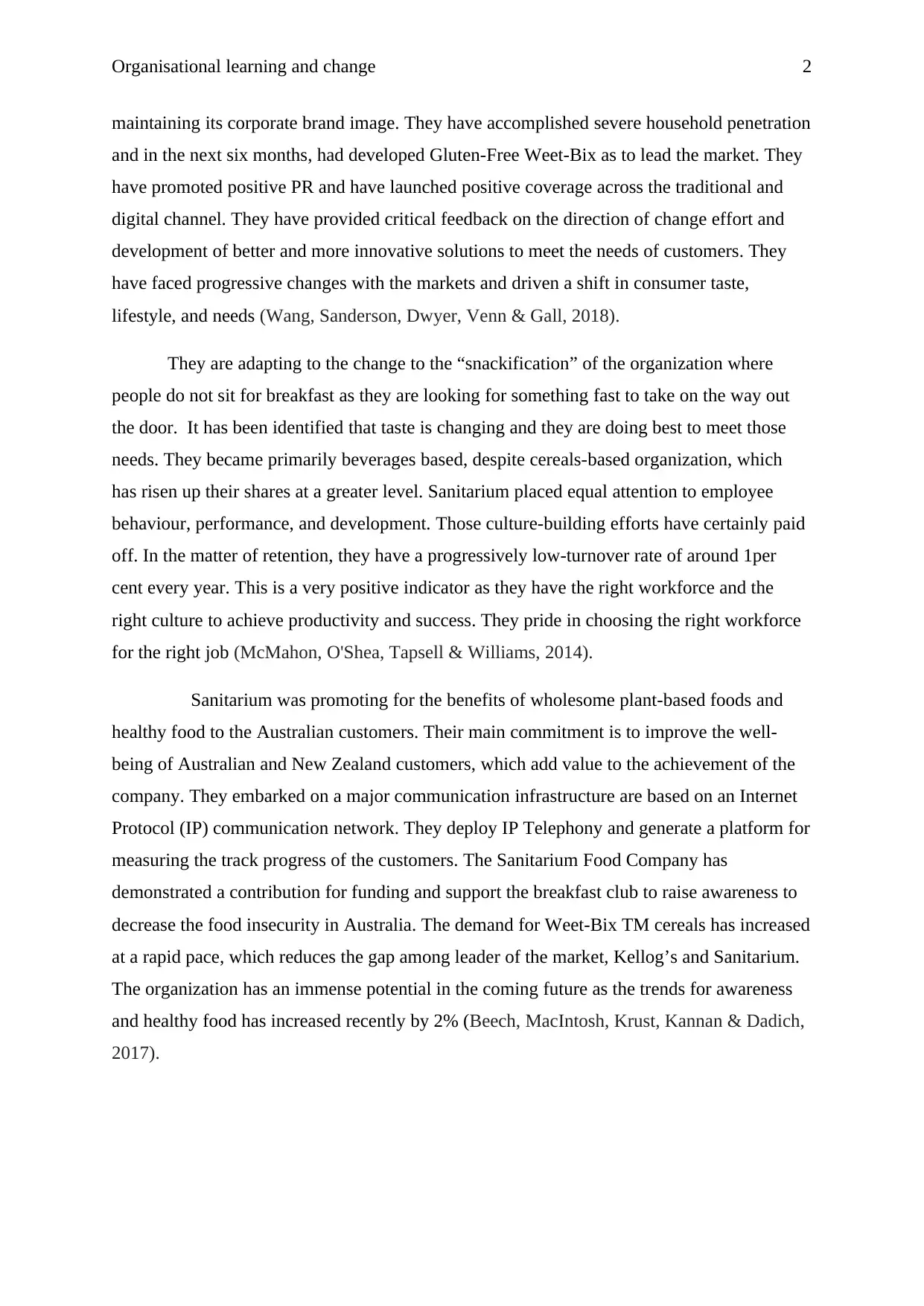
Organisational learning and change 2
maintaining its corporate brand image. They have accomplished severe household penetration
and in the next six months, had developed Gluten-Free Weet-Bix as to lead the market. They
have promoted positive PR and have launched positive coverage across the traditional and
digital channel. They have provided critical feedback on the direction of change effort and
development of better and more innovative solutions to meet the needs of customers. They
have faced progressive changes with the markets and driven a shift in consumer taste,
lifestyle, and needs (Wang, Sanderson, Dwyer, Venn & Gall, 2018).
They are adapting to the change to the “snackification” of the organization where
people do not sit for breakfast as they are looking for something fast to take on the way out
the door. It has been identified that taste is changing and they are doing best to meet those
needs. They became primarily beverages based, despite cereals-based organization, which
has risen up their shares at a greater level. Sanitarium placed equal attention to employee
behaviour, performance, and development. Those culture-building efforts have certainly paid
off. In the matter of retention, they have a progressively low-turnover rate of around 1per
cent every year. This is a very positive indicator as they have the right workforce and the
right culture to achieve productivity and success. They pride in choosing the right workforce
for the right job (McMahon, O'Shea, Tapsell & Williams, 2014).
Sanitarium was promoting for the benefits of wholesome plant-based foods and
healthy food to the Australian customers. Their main commitment is to improve the well-
being of Australian and New Zealand customers, which add value to the achievement of the
company. They embarked on a major communication infrastructure are based on an Internet
Protocol (IP) communication network. They deploy IP Telephony and generate a platform for
measuring the track progress of the customers. The Sanitarium Food Company has
demonstrated a contribution for funding and support the breakfast club to raise awareness to
decrease the food insecurity in Australia. The demand for Weet-Bix TM cereals has increased
at a rapid pace, which reduces the gap among leader of the market, Kellog’s and Sanitarium.
The organization has an immense potential in the coming future as the trends for awareness
and healthy food has increased recently by 2% (Beech, MacIntosh, Krust, Kannan & Dadich,
2017).
maintaining its corporate brand image. They have accomplished severe household penetration
and in the next six months, had developed Gluten-Free Weet-Bix as to lead the market. They
have promoted positive PR and have launched positive coverage across the traditional and
digital channel. They have provided critical feedback on the direction of change effort and
development of better and more innovative solutions to meet the needs of customers. They
have faced progressive changes with the markets and driven a shift in consumer taste,
lifestyle, and needs (Wang, Sanderson, Dwyer, Venn & Gall, 2018).
They are adapting to the change to the “snackification” of the organization where
people do not sit for breakfast as they are looking for something fast to take on the way out
the door. It has been identified that taste is changing and they are doing best to meet those
needs. They became primarily beverages based, despite cereals-based organization, which
has risen up their shares at a greater level. Sanitarium placed equal attention to employee
behaviour, performance, and development. Those culture-building efforts have certainly paid
off. In the matter of retention, they have a progressively low-turnover rate of around 1per
cent every year. This is a very positive indicator as they have the right workforce and the
right culture to achieve productivity and success. They pride in choosing the right workforce
for the right job (McMahon, O'Shea, Tapsell & Williams, 2014).
Sanitarium was promoting for the benefits of wholesome plant-based foods and
healthy food to the Australian customers. Their main commitment is to improve the well-
being of Australian and New Zealand customers, which add value to the achievement of the
company. They embarked on a major communication infrastructure are based on an Internet
Protocol (IP) communication network. They deploy IP Telephony and generate a platform for
measuring the track progress of the customers. The Sanitarium Food Company has
demonstrated a contribution for funding and support the breakfast club to raise awareness to
decrease the food insecurity in Australia. The demand for Weet-Bix TM cereals has increased
at a rapid pace, which reduces the gap among leader of the market, Kellog’s and Sanitarium.
The organization has an immense potential in the coming future as the trends for awareness
and healthy food has increased recently by 2% (Beech, MacIntosh, Krust, Kannan & Dadich,
2017).
⊘ This is a preview!⊘
Do you want full access?
Subscribe today to unlock all pages.

Trusted by 1+ million students worldwide
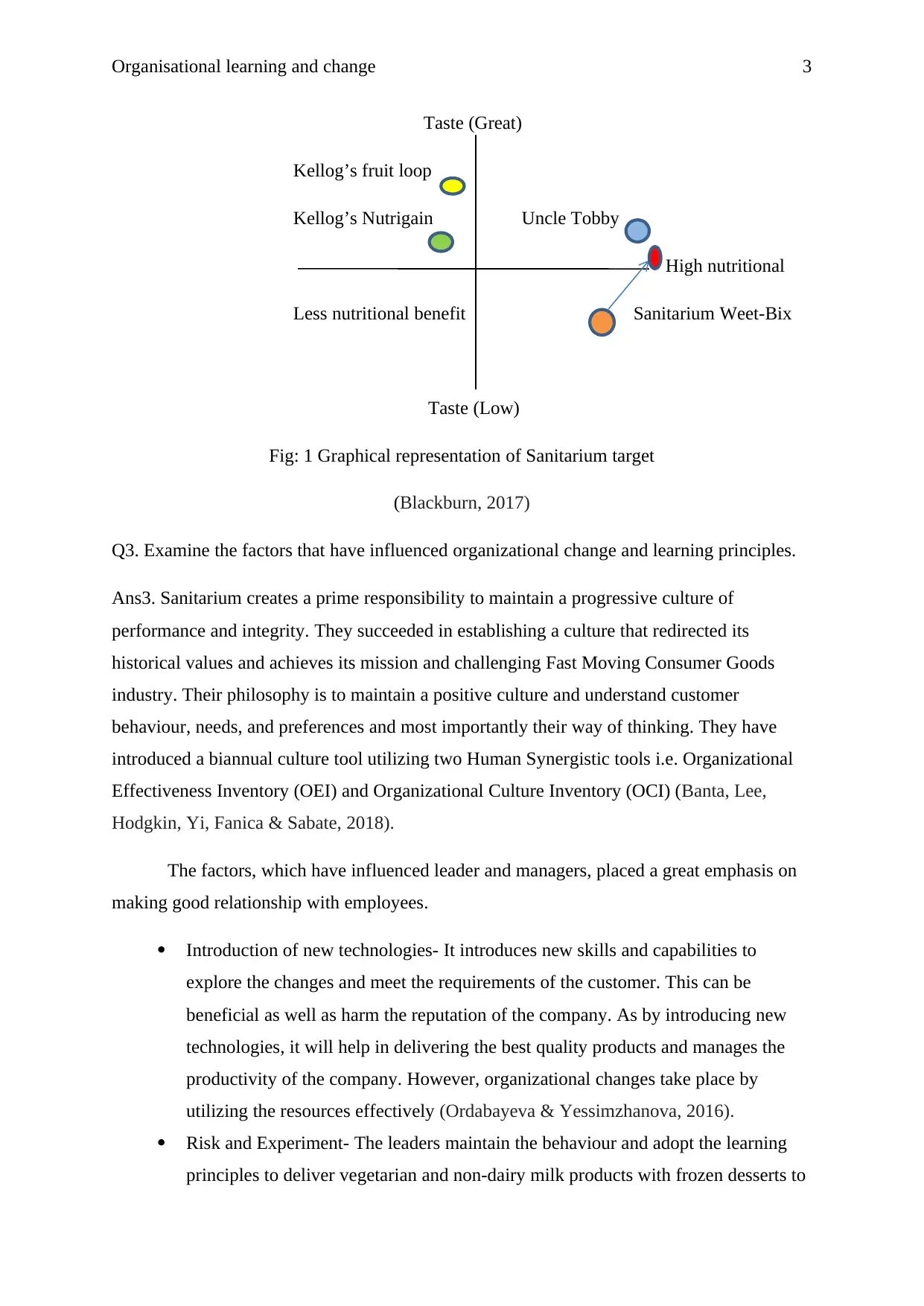
Organisational learning and change 3
Taste (Great)
Kellog’s fruit loop
Kellog’s Nutrigain Uncle Tobby
High nutritional
Less nutritional benefit Sanitarium Weet-Bix
Taste (Low)
Fig: 1 Graphical representation of Sanitarium target
(Blackburn, 2017)
Q3. Examine the factors that have influenced organizational change and learning principles.
Ans3. Sanitarium creates a prime responsibility to maintain a progressive culture of
performance and integrity. They succeeded in establishing a culture that redirected its
historical values and achieves its mission and challenging Fast Moving Consumer Goods
industry. Their philosophy is to maintain a positive culture and understand customer
behaviour, needs, and preferences and most importantly their way of thinking. They have
introduced a biannual culture tool utilizing two Human Synergistic tools i.e. Organizational
Effectiveness Inventory (OEI) and Organizational Culture Inventory (OCI) (Banta, Lee,
Hodgkin, Yi, Fanica & Sabate, 2018).
The factors, which have influenced leader and managers, placed a great emphasis on
making good relationship with employees.
Introduction of new technologies- It introduces new skills and capabilities to
explore the changes and meet the requirements of the customer. This can be
beneficial as well as harm the reputation of the company. As by introducing new
technologies, it will help in delivering the best quality products and manages the
productivity of the company. However, organizational changes take place by
utilizing the resources effectively (Ordabayeva & Yessimzhanova, 2016).
Risk and Experiment- The leaders maintain the behaviour and adopt the learning
principles to deliver vegetarian and non-dairy milk products with frozen desserts to
Taste (Great)
Kellog’s fruit loop
Kellog’s Nutrigain Uncle Tobby
High nutritional
Less nutritional benefit Sanitarium Weet-Bix
Taste (Low)
Fig: 1 Graphical representation of Sanitarium target
(Blackburn, 2017)
Q3. Examine the factors that have influenced organizational change and learning principles.
Ans3. Sanitarium creates a prime responsibility to maintain a progressive culture of
performance and integrity. They succeeded in establishing a culture that redirected its
historical values and achieves its mission and challenging Fast Moving Consumer Goods
industry. Their philosophy is to maintain a positive culture and understand customer
behaviour, needs, and preferences and most importantly their way of thinking. They have
introduced a biannual culture tool utilizing two Human Synergistic tools i.e. Organizational
Effectiveness Inventory (OEI) and Organizational Culture Inventory (OCI) (Banta, Lee,
Hodgkin, Yi, Fanica & Sabate, 2018).
The factors, which have influenced leader and managers, placed a great emphasis on
making good relationship with employees.
Introduction of new technologies- It introduces new skills and capabilities to
explore the changes and meet the requirements of the customer. This can be
beneficial as well as harm the reputation of the company. As by introducing new
technologies, it will help in delivering the best quality products and manages the
productivity of the company. However, organizational changes take place by
utilizing the resources effectively (Ordabayeva & Yessimzhanova, 2016).
Risk and Experiment- The leaders maintain the behaviour and adopt the learning
principles to deliver vegetarian and non-dairy milk products with frozen desserts to
Paraphrase This Document
Need a fresh take? Get an instant paraphrase of this document with our AI Paraphraser
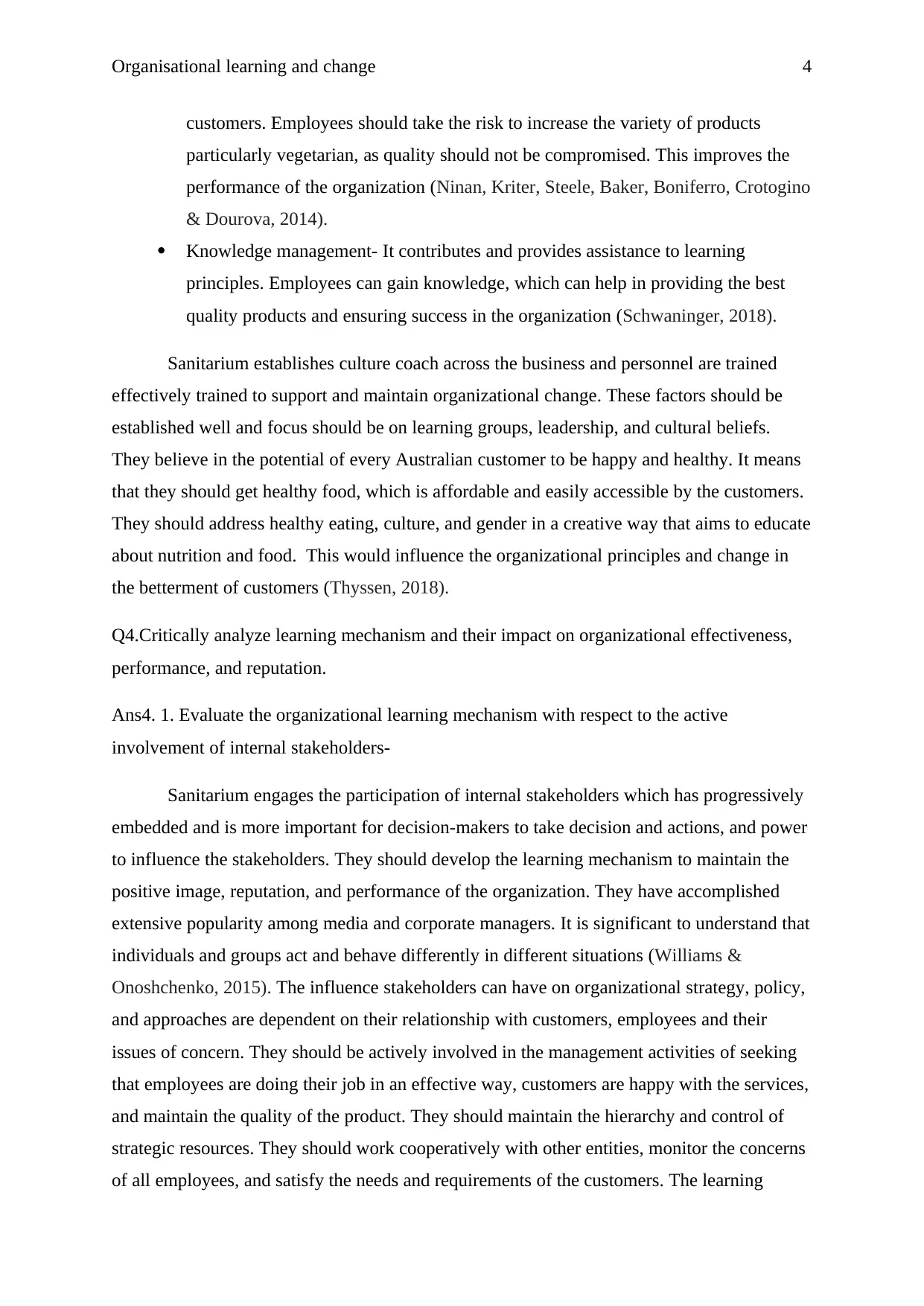
Organisational learning and change 4
customers. Employees should take the risk to increase the variety of products
particularly vegetarian, as quality should not be compromised. This improves the
performance of the organization (Ninan, Kriter, Steele, Baker, Boniferro, Crotogino
& Dourova, 2014).
Knowledge management- It contributes and provides assistance to learning
principles. Employees can gain knowledge, which can help in providing the best
quality products and ensuring success in the organization (Schwaninger, 2018).
Sanitarium establishes culture coach across the business and personnel are trained
effectively trained to support and maintain organizational change. These factors should be
established well and focus should be on learning groups, leadership, and cultural beliefs.
They believe in the potential of every Australian customer to be happy and healthy. It means
that they should get healthy food, which is affordable and easily accessible by the customers.
They should address healthy eating, culture, and gender in a creative way that aims to educate
about nutrition and food. This would influence the organizational principles and change in
the betterment of customers (Thyssen, 2018).
Q4.Critically analyze learning mechanism and their impact on organizational effectiveness,
performance, and reputation.
Ans4. 1. Evaluate the organizational learning mechanism with respect to the active
involvement of internal stakeholders-
Sanitarium engages the participation of internal stakeholders which has progressively
embedded and is more important for decision-makers to take decision and actions, and power
to influence the stakeholders. They should develop the learning mechanism to maintain the
positive image, reputation, and performance of the organization. They have accomplished
extensive popularity among media and corporate managers. It is significant to understand that
individuals and groups act and behave differently in different situations (Williams &
Onoshchenko, 2015). The influence stakeholders can have on organizational strategy, policy,
and approaches are dependent on their relationship with customers, employees and their
issues of concern. They should be actively involved in the management activities of seeking
that employees are doing their job in an effective way, customers are happy with the services,
and maintain the quality of the product. They should maintain the hierarchy and control of
strategic resources. They should work cooperatively with other entities, monitor the concerns
of all employees, and satisfy the needs and requirements of the customers. The learning
customers. Employees should take the risk to increase the variety of products
particularly vegetarian, as quality should not be compromised. This improves the
performance of the organization (Ninan, Kriter, Steele, Baker, Boniferro, Crotogino
& Dourova, 2014).
Knowledge management- It contributes and provides assistance to learning
principles. Employees can gain knowledge, which can help in providing the best
quality products and ensuring success in the organization (Schwaninger, 2018).
Sanitarium establishes culture coach across the business and personnel are trained
effectively trained to support and maintain organizational change. These factors should be
established well and focus should be on learning groups, leadership, and cultural beliefs.
They believe in the potential of every Australian customer to be happy and healthy. It means
that they should get healthy food, which is affordable and easily accessible by the customers.
They should address healthy eating, culture, and gender in a creative way that aims to educate
about nutrition and food. This would influence the organizational principles and change in
the betterment of customers (Thyssen, 2018).
Q4.Critically analyze learning mechanism and their impact on organizational effectiveness,
performance, and reputation.
Ans4. 1. Evaluate the organizational learning mechanism with respect to the active
involvement of internal stakeholders-
Sanitarium engages the participation of internal stakeholders which has progressively
embedded and is more important for decision-makers to take decision and actions, and power
to influence the stakeholders. They should develop the learning mechanism to maintain the
positive image, reputation, and performance of the organization. They have accomplished
extensive popularity among media and corporate managers. It is significant to understand that
individuals and groups act and behave differently in different situations (Williams &
Onoshchenko, 2015). The influence stakeholders can have on organizational strategy, policy,
and approaches are dependent on their relationship with customers, employees and their
issues of concern. They should be actively involved in the management activities of seeking
that employees are doing their job in an effective way, customers are happy with the services,
and maintain the quality of the product. They should maintain the hierarchy and control of
strategic resources. They should work cooperatively with other entities, monitor the concerns
of all employees, and satisfy the needs and requirements of the customers. The learning
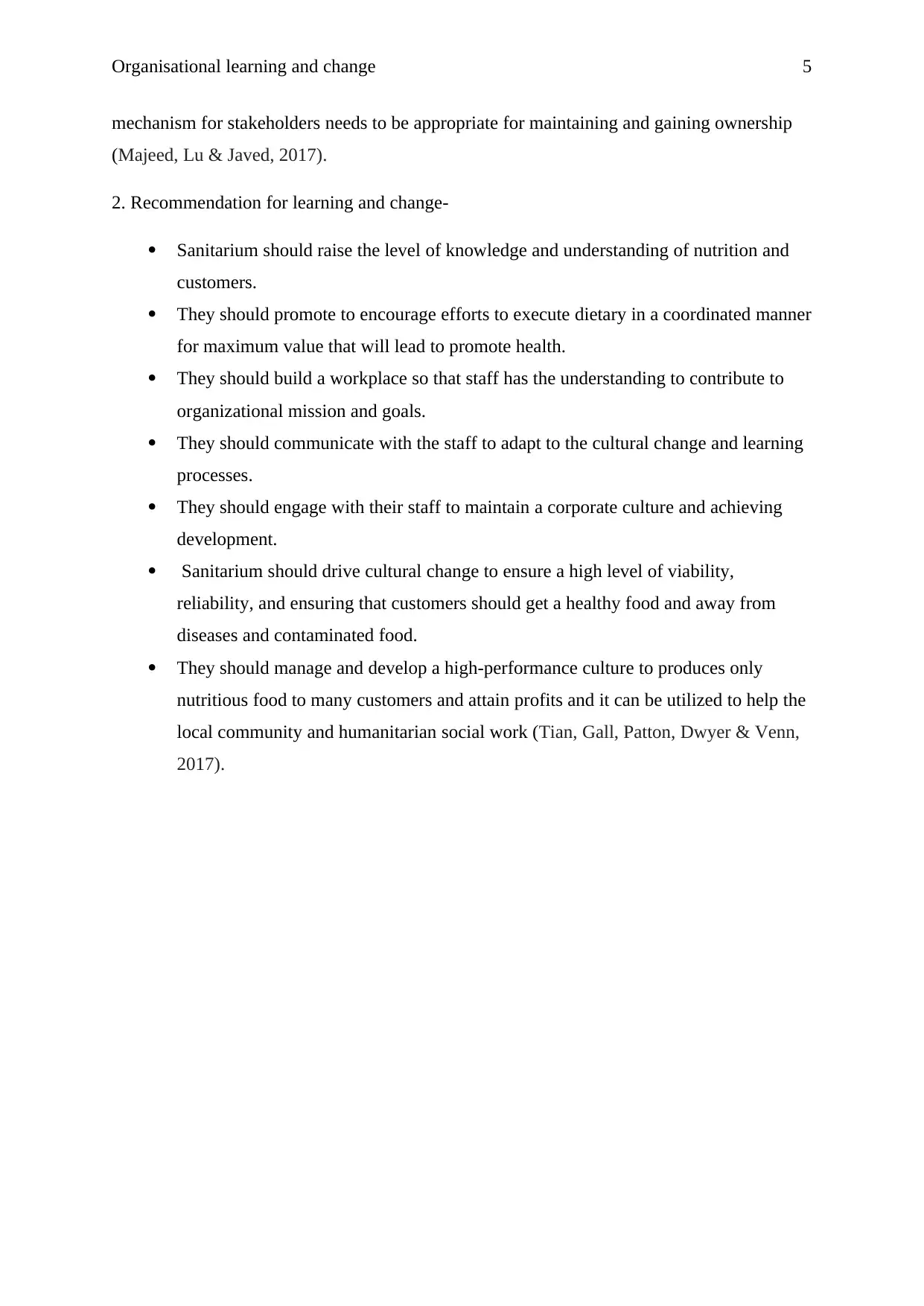
Organisational learning and change 5
mechanism for stakeholders needs to be appropriate for maintaining and gaining ownership
(Majeed, Lu & Javed, 2017).
2. Recommendation for learning and change-
Sanitarium should raise the level of knowledge and understanding of nutrition and
customers.
They should promote to encourage efforts to execute dietary in a coordinated manner
for maximum value that will lead to promote health.
They should build a workplace so that staff has the understanding to contribute to
organizational mission and goals.
They should communicate with the staff to adapt to the cultural change and learning
processes.
They should engage with their staff to maintain a corporate culture and achieving
development.
Sanitarium should drive cultural change to ensure a high level of viability,
reliability, and ensuring that customers should get a healthy food and away from
diseases and contaminated food.
They should manage and develop a high-performance culture to produces only
nutritious food to many customers and attain profits and it can be utilized to help the
local community and humanitarian social work (Tian, Gall, Patton, Dwyer & Venn,
2017).
mechanism for stakeholders needs to be appropriate for maintaining and gaining ownership
(Majeed, Lu & Javed, 2017).
2. Recommendation for learning and change-
Sanitarium should raise the level of knowledge and understanding of nutrition and
customers.
They should promote to encourage efforts to execute dietary in a coordinated manner
for maximum value that will lead to promote health.
They should build a workplace so that staff has the understanding to contribute to
organizational mission and goals.
They should communicate with the staff to adapt to the cultural change and learning
processes.
They should engage with their staff to maintain a corporate culture and achieving
development.
Sanitarium should drive cultural change to ensure a high level of viability,
reliability, and ensuring that customers should get a healthy food and away from
diseases and contaminated food.
They should manage and develop a high-performance culture to produces only
nutritious food to many customers and attain profits and it can be utilized to help the
local community and humanitarian social work (Tian, Gall, Patton, Dwyer & Venn,
2017).
⊘ This is a preview!⊘
Do you want full access?
Subscribe today to unlock all pages.

Trusted by 1+ million students worldwide
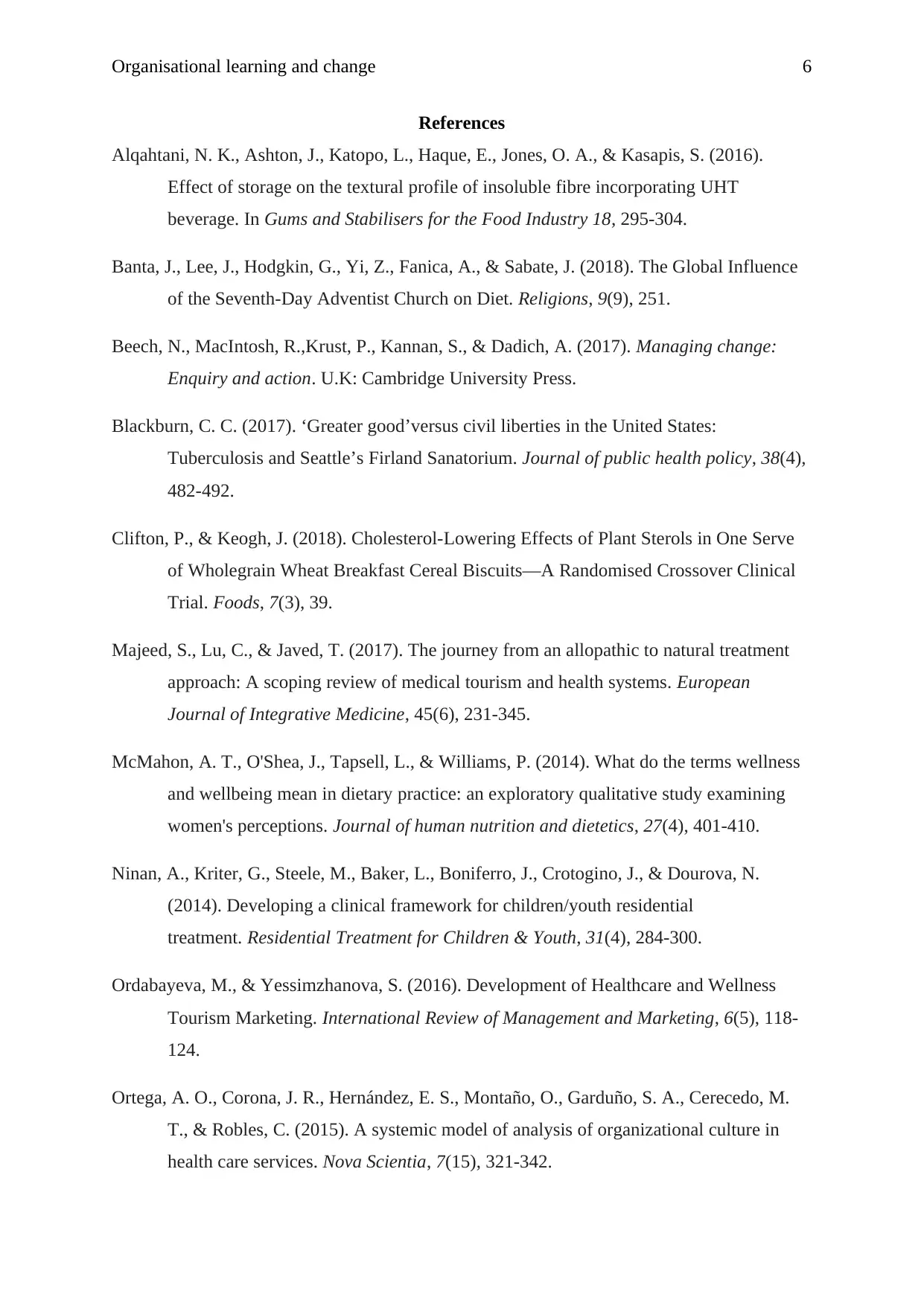
Organisational learning and change 6
References
Alqahtani, N. K., Ashton, J., Katopo, L., Haque, E., Jones, O. A., & Kasapis, S. (2016).
Effect of storage on the textural profile of insoluble fibre incorporating UHT
beverage. In Gums and Stabilisers for the Food Industry 18, 295-304.
Banta, J., Lee, J., Hodgkin, G., Yi, Z., Fanica, A., & Sabate, J. (2018). The Global Influence
of the Seventh-Day Adventist Church on Diet. Religions, 9(9), 251.
Beech, N., MacIntosh, R.,Krust, P., Kannan, S., & Dadich, A. (2017). Managing change:
Enquiry and action. U.K: Cambridge University Press.
Blackburn, C. C. (2017). ‘Greater good’versus civil liberties in the United States:
Tuberculosis and Seattle’s Firland Sanatorium. Journal of public health policy, 38(4),
482-492.
Clifton, P., & Keogh, J. (2018). Cholesterol-Lowering Effects of Plant Sterols in One Serve
of Wholegrain Wheat Breakfast Cereal Biscuits—A Randomised Crossover Clinical
Trial. Foods, 7(3), 39.
Majeed, S., Lu, C., & Javed, T. (2017). The journey from an allopathic to natural treatment
approach: A scoping review of medical tourism and health systems. European
Journal of Integrative Medicine, 45(6), 231-345.
McMahon, A. T., O'Shea, J., Tapsell, L., & Williams, P. (2014). What do the terms wellness
and wellbeing mean in dietary practice: an exploratory qualitative study examining
women's perceptions. Journal of human nutrition and dietetics, 27(4), 401-410.
Ninan, A., Kriter, G., Steele, M., Baker, L., Boniferro, J., Crotogino, J., & Dourova, N.
(2014). Developing a clinical framework for children/youth residential
treatment. Residential Treatment for Children & Youth, 31(4), 284-300.
Ordabayeva, M., & Yessimzhanova, S. (2016). Development of Healthcare and Wellness
Tourism Marketing. International Review of Management and Marketing, 6(5), 118-
124.
Ortega, A. O., Corona, J. R., Hernández, E. S., Montaño, O., Garduño, S. A., Cerecedo, M.
T., & Robles, C. (2015). A systemic model of analysis of organizational culture in
health care services. Nova Scientia, 7(15), 321-342.
References
Alqahtani, N. K., Ashton, J., Katopo, L., Haque, E., Jones, O. A., & Kasapis, S. (2016).
Effect of storage on the textural profile of insoluble fibre incorporating UHT
beverage. In Gums and Stabilisers for the Food Industry 18, 295-304.
Banta, J., Lee, J., Hodgkin, G., Yi, Z., Fanica, A., & Sabate, J. (2018). The Global Influence
of the Seventh-Day Adventist Church on Diet. Religions, 9(9), 251.
Beech, N., MacIntosh, R.,Krust, P., Kannan, S., & Dadich, A. (2017). Managing change:
Enquiry and action. U.K: Cambridge University Press.
Blackburn, C. C. (2017). ‘Greater good’versus civil liberties in the United States:
Tuberculosis and Seattle’s Firland Sanatorium. Journal of public health policy, 38(4),
482-492.
Clifton, P., & Keogh, J. (2018). Cholesterol-Lowering Effects of Plant Sterols in One Serve
of Wholegrain Wheat Breakfast Cereal Biscuits—A Randomised Crossover Clinical
Trial. Foods, 7(3), 39.
Majeed, S., Lu, C., & Javed, T. (2017). The journey from an allopathic to natural treatment
approach: A scoping review of medical tourism and health systems. European
Journal of Integrative Medicine, 45(6), 231-345.
McMahon, A. T., O'Shea, J., Tapsell, L., & Williams, P. (2014). What do the terms wellness
and wellbeing mean in dietary practice: an exploratory qualitative study examining
women's perceptions. Journal of human nutrition and dietetics, 27(4), 401-410.
Ninan, A., Kriter, G., Steele, M., Baker, L., Boniferro, J., Crotogino, J., & Dourova, N.
(2014). Developing a clinical framework for children/youth residential
treatment. Residential Treatment for Children & Youth, 31(4), 284-300.
Ordabayeva, M., & Yessimzhanova, S. (2016). Development of Healthcare and Wellness
Tourism Marketing. International Review of Management and Marketing, 6(5), 118-
124.
Ortega, A. O., Corona, J. R., Hernández, E. S., Montaño, O., Garduño, S. A., Cerecedo, M.
T., & Robles, C. (2015). A systemic model of analysis of organizational culture in
health care services. Nova Scientia, 7(15), 321-342.
Paraphrase This Document
Need a fresh take? Get an instant paraphrase of this document with our AI Paraphraser
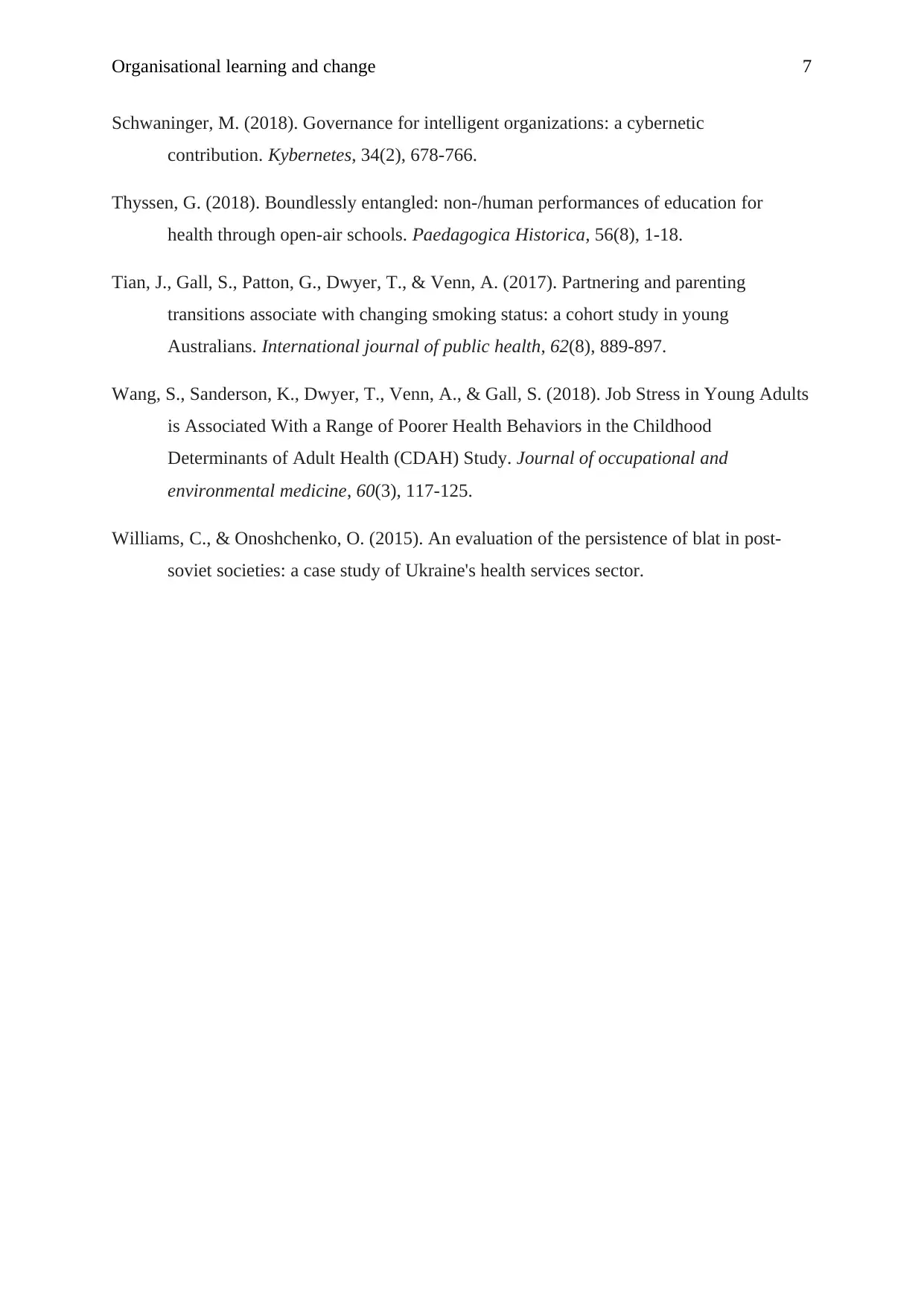
Organisational learning and change 7
Schwaninger, M. (2018). Governance for intelligent organizations: a cybernetic
contribution. Kybernetes, 34(2), 678-766.
Thyssen, G. (2018). Boundlessly entangled: non-/human performances of education for
health through open-air schools. Paedagogica Historica, 56(8), 1-18.
Tian, J., Gall, S., Patton, G., Dwyer, T., & Venn, A. (2017). Partnering and parenting
transitions associate with changing smoking status: a cohort study in young
Australians. International journal of public health, 62(8), 889-897.
Wang, S., Sanderson, K., Dwyer, T., Venn, A., & Gall, S. (2018). Job Stress in Young Adults
is Associated With a Range of Poorer Health Behaviors in the Childhood
Determinants of Adult Health (CDAH) Study. Journal of occupational and
environmental medicine, 60(3), 117-125.
Williams, C., & Onoshchenko, O. (2015). An evaluation of the persistence of blat in post-
soviet societies: a case study of Ukraine's health services sector.
Schwaninger, M. (2018). Governance for intelligent organizations: a cybernetic
contribution. Kybernetes, 34(2), 678-766.
Thyssen, G. (2018). Boundlessly entangled: non-/human performances of education for
health through open-air schools. Paedagogica Historica, 56(8), 1-18.
Tian, J., Gall, S., Patton, G., Dwyer, T., & Venn, A. (2017). Partnering and parenting
transitions associate with changing smoking status: a cohort study in young
Australians. International journal of public health, 62(8), 889-897.
Wang, S., Sanderson, K., Dwyer, T., Venn, A., & Gall, S. (2018). Job Stress in Young Adults
is Associated With a Range of Poorer Health Behaviors in the Childhood
Determinants of Adult Health (CDAH) Study. Journal of occupational and
environmental medicine, 60(3), 117-125.
Williams, C., & Onoshchenko, O. (2015). An evaluation of the persistence of blat in post-
soviet societies: a case study of Ukraine's health services sector.
1 out of 8
Related Documents
Your All-in-One AI-Powered Toolkit for Academic Success.
+13062052269
info@desklib.com
Available 24*7 on WhatsApp / Email
![[object Object]](/_next/static/media/star-bottom.7253800d.svg)
Unlock your academic potential
Copyright © 2020–2025 A2Z Services. All Rights Reserved. Developed and managed by ZUCOL.




